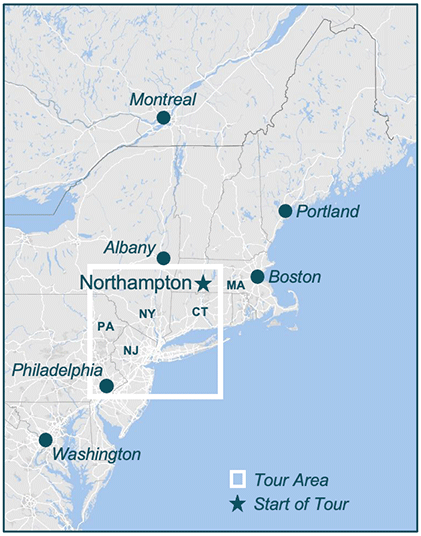

Science, History and Art in the Northeast US Tour Package
Explore the intersections of paleontology, geology, astronomy, art and architecture from the center of the deep-time supercontinent of Pangea
Highlights
- New Scientist Discovery Tour in partnership with GeoCultura.
- Explore the 200-million-year-old break-up of the supercontinent of Pangea and how it led to the end-Triassic mass extinction event, the ascent of the dinosaurs, one of the world’s largest flood basalt events and giant rift lakes.
- See the record of the dinosaurs themselves in the backrooms of the American Museum of Natural History in Manhattan and in thousands of footprints along the Connecticut River.
- Find out how the planets really do influence climate and our lives – and it’s not astrology – and see how chaos in the Solar System evolved!
- See how geological events influenced artists, especially the Hudson River School’s Thomas Cole and Frederic Church, and later Edward Hopper: see and hear about their art at The Metropolitan Museum of Art in New York City and at their homes in the Hudson Valley.
- Enjoy an architecture cruise around the island of Manhattan.
- The tour begins in Northampton, Massachusetts and ends in Philadelphia, Pennsylvania.
Overview
In addition to hosting a nearly incomparable treasure-house of museums and culture, the Philadelphia-New York-Boston megalopolis offers world-class geology, including one of the best geological and paleontological records of the rise of the dinosaurs to ecological dominance and arguably the best and most accessible demonstration of how astronomy influences climate and history. Spectacular quarry exposures, natural outcrops, fossil collecting sites and museum collections illustrate how deep-time events, and processes still in operation, influenced our past and still influence the present.
We will see how American art and architecture were shaped by events that occurred 200 million years ago. The present landscape, which evolved from the bedrock disrupted during the break-up of the Pangean supercontinent, provided the raw material for the distinctively American Hudson River School of Painting and later art.
Visits to the American Museum of Natural History (including time in back-rooms not normally open to the public) and The Metropolitan Museum of Art in Manhattan, to the Beneski Museum of Natural History in Amherst and to the campus of the Lamont-Doherty Earth Observatory of Columbia University showcase the relevant art and science. The tour includes a boat cruise around Manhattan to savor the spectacular architecture of the city, the Statue of Liberty and the beautiful geology of the Palisades.
Activity Level: Easy, with walks in the outdoors and in museums of up to 1 mile (1.6km) on most days (view activity level definitions). Some paths and trails will be rough and irregular.
Transport: We will use a comfortable coach suited to the number of attendees.
Accommodation: We will be in first class hotels in Northampton, Hudson, Manhattan and Lambertville. The hotel in NYC is on the Upper West Side and is well positioned to access museums, restaurants and Central Park. See our list of hotels in the Need to Know tab.
Weather: Generally good in the early Autumn with mild days and cool evenings. Occasional rain showers are likely.
Tour Map
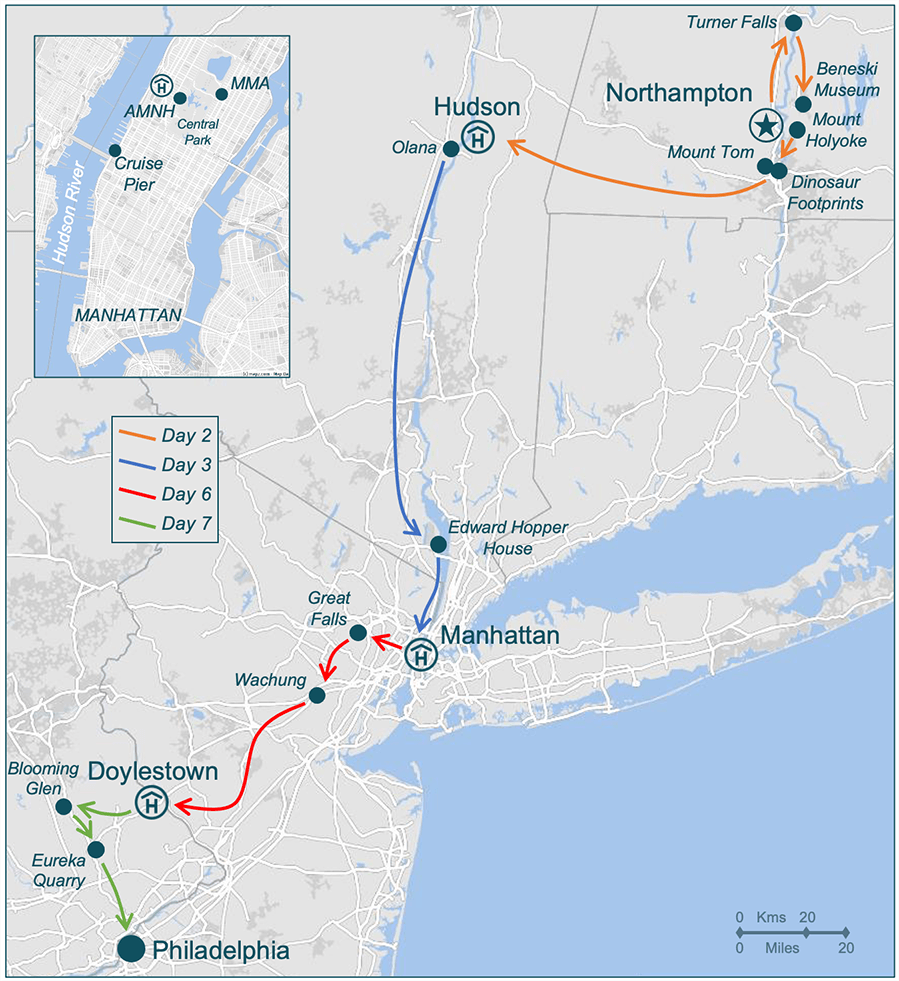
Day 1 – Arrival in Northampton, MA

The group will assemble mid-afternoon for introductions and a visit to the nearby Beneski Museum of Natural History at Amherst College.
The Beneski Museum has the famous Hitchcock Ichnological Cabinet, housing thousands of beautifully displayed Jurassic dinosaur and other footprints assembled by Edward Hitchcock. Amongst these footprints are some revealing that these animals bore both scales and feathers, showing that Hitchcock’s belief the tracks belonged to birds, which he took to his grave, was in fact prescient in ways he could not have imagined.
Overnight in Northampton. Group dinner.
Day 2 – Northampton to Hudson, NY: American Industrial Revolution, dinosaurs, celestial mechanics
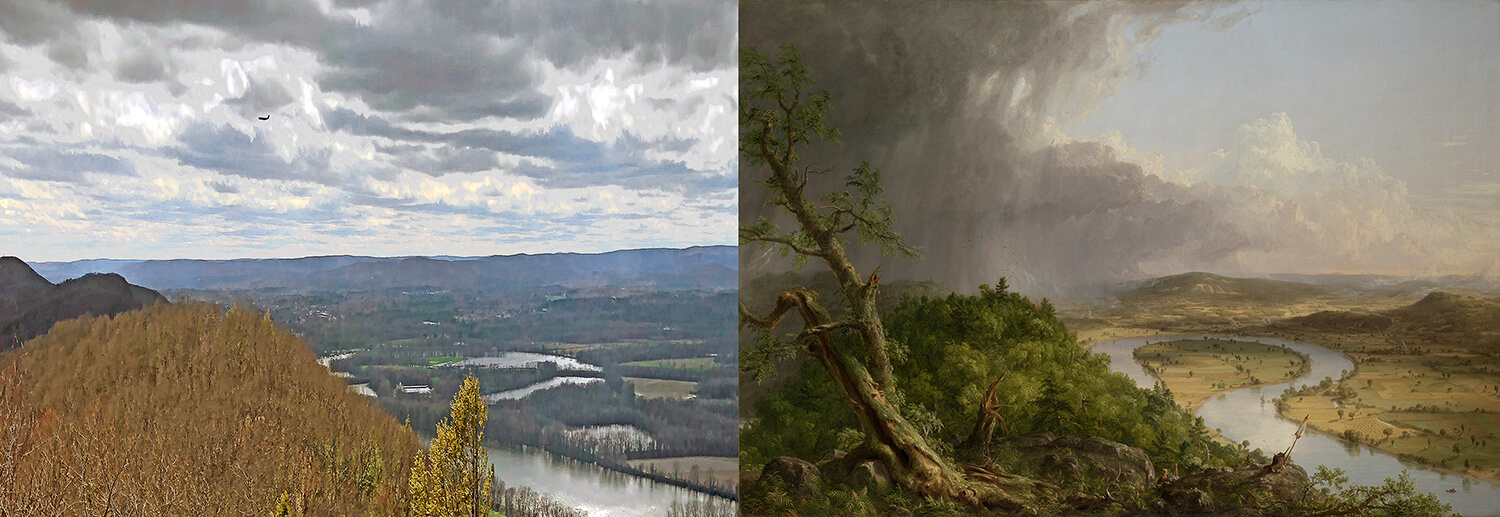
The first full day will be spent in the northern Hartford and adjacent Deerfield Rift Basins examining the consequences of the end-Triassic extinction.
The first stop is Summit House on the giant, Jurassic age Holyoke lava flow, one of the largest eruptive events in Earth history, covering 11 million square kilometers. This where here Thomas Cole painted “View from Mount Holyoke, Northampton, Massachusetts, after a Thunderstorm —The Oxbow”, a painting we will see on day 5 at the Metropolitan Museum of Art in New York. The work view bemoans the Industrial Revolution then sweeping across the United States.
We then travel north to Montague, Massachusetts, home to the second freight canal in North America (1776) and to an industrial village based on water power (1866). The Jurassic strata under the Great Falls have produced thousands of fish fossils and nearly as many dinosaur and other footprints. Lake strata above lava flows clearly record the cyclicity caused by climate changes paced by variations in the Earth’s axis and orbit tracking the gravitational dance of the planets. These Milankovitch cycles are still operating today.
Following a lunch with spectacular views of Mount Holyoke we will travel south to nearby Mount Tom State Reservation to visit a large, abandoned quarry in the Holyoke Basalt lava flow.
The last stop of the day will be the “Dinosaur Footprints” preserve on the bank of the Connecticut River which produced the first reported dinosaur footprints, described in 1836 by the Reverend Edward Hitchcock of Amherst College as tracks of giant birds.
Overnight in Hudson, NY. Free evening.
Day 3 – Hudson to New York City: The Hudson Valley and Hudson Valley School

Today we focus on Hudson Valley geology and its influence on art, beginning on the west side of the Hudson River with a visit to the house and studio of the founder of the Hudson River School of painting, Thomas Cole. We then drive across the Rip Van Winkle Bridge to the east side of the Hudson for a short, guided tour of Olana, the spectacular estate of Cole’s disciple Fredric Church.
We then travel to Nyack, New York, the early home of the thoroughly American artist Edward Hopper. We will stop at the former Manhattan Quarry, depicted in one of Hopper’s watercolors and now Nyack Beach State Park, to see Late Triassic river and lake deposits and the Palisade Sill, an extensive complex of igneous rocks that is a part of the Central Atlantic Magmatic Province (CAMP). This and other quarries provided the facade for New York City’s ubiquitous brownstones (townhouses); a successful campaign to save the Palisades converted all the quarries facing the Hudson into the Palisades Interstate Park.
We then travel a short way south to Lamont-Doherty Earth Observatory of Columbia University where we will have a talk on paleoastronomy coupled with a viewing of sediment cores from the 200-230 million-year-old Newark Rift Valley and much more recent cores of the last million years from the Mediterranean Sea, both spectacularly showing the influence of Milankovitch cycles as well as the effects of chaos in the Solar System.
Overnight in Manhattan, NY. Free evening.
Days 4 and 5 – NYC: Time at the museums, a Central Park geology walk and a cruise

The group will visit two of the world’s great museums.
Day 4 will begin at the American Museum of Natural History, with a pre-opening special tour of the Geology and Dinosaur galleries and a “behind the scenes” look at the paleontology areas. This will be followed by a guided walk exploring the geology of adjacent Central Park. The afternoon and evening will be free to explore the many sites of the city (we can make recommendations!).
Day 5 will commence across Central Park at The Metropolitan Museum of Art with a look at paintings of the Hudson River School, the first truly American style of painting, by Thomas Cole (including his “View from Mount Holyoke, Northampton, Massachusetts, after a Thunderstorm - The Oxbow”, the setting for which we saw on our first full day), Frederic Church and Edward Hopper. There are many other paintings related to geology, landscapes, and science we will view.
In the afternoon we will embark on an architectural boat trip around Manhattan. An expert from the American Institute of Architects will provide commentary on Art Deco spires, engineering marvels and recent buildings by noted architects as we cruise the Hudson, East and Harlem rivers. The tour will also feature geological highlights such as the Palisades (a giant magma intrusion of the Central Atlantic Igneous Province).
Overnights in Manhattan, NY. Free evenings.
Day 6 – Manhattan to Doylestown, PA: The Newark Triassic-Jurassic rift and the end-Triassic mass extinction
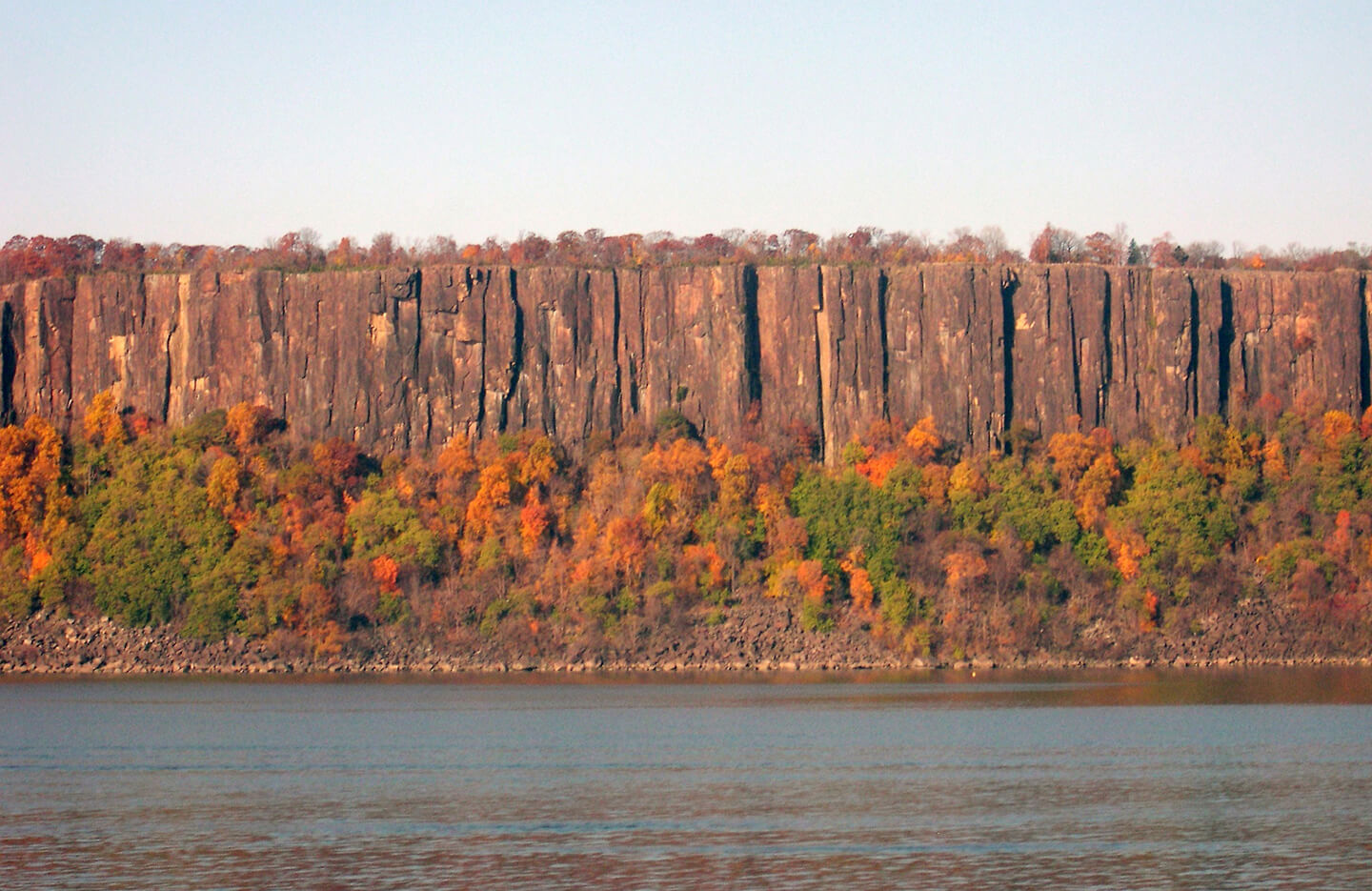
After traveling west from Manhattan, we will walk through a wooded set of gorges at Pompton, New Jersey, that held a 19th century forge. Nearby outcrops will allow us to get up close and personal with highly fish-fossil-rich Jurassic-age strata deposited in great lakes.
We will lunch on one of the oldest lava flows of the CAMP at an overview of the Great Falls of the Passaic River. Following the Battle of Monmouth on July 10, 1778, Alexander Hamilton convinced George Washington and the Marquis de Lafeyette that this would be a great site for an industrial center.
We continue south to the Watchung Reservation, a nature reserve that includes a complex of 18th-century houses, the 19th-century paper mill village of Feltville and outcrops with fossil fish and dinosaur footprints.
The day’s last stop will be at a large active quarry in lava flows of the CAMP. The eruptions of the flows released carbon dioxide and sulfur that caused the end-Triassic mass extinction, but ironically in the future may be used to sequester human-produced fossil-fuel carbon dioxide. After cooling, fissures, caves and lava tubes trapped various reptiles, the remains of which are found here.
Overnight in Doylestown, PA. Final group dinner.
Day 7 – Doylestown to Philadelphia, PA: Triassic astronomically-paced lake cycles and fossils; tour’s end
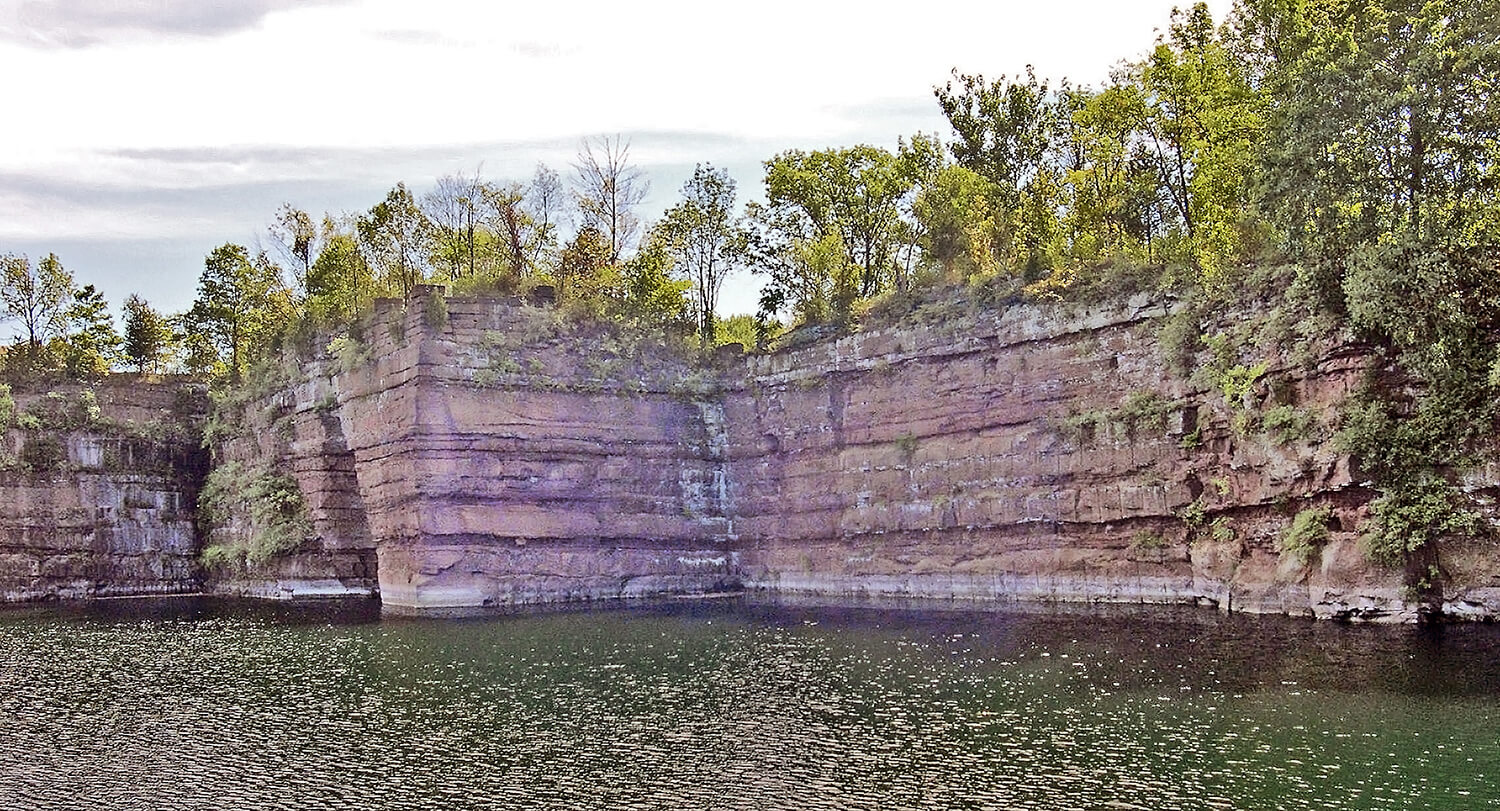
The morning will begin with a visit to two huge active quarries revealing sediments deposited in Late Triassic giant lakes that waxed and waned in depth with wet-dry cycles paced by variations in the Earth’s axial orientation and orbit. When deep, these lakes were home to numerous fishes and reptiles that left their remains as fossils, some of which we will no doubt find.
Following a picnic lunch and a display of rock cores and fossils, illustrating major concepts of our tour, we will visit two additional spectacular active quarries. One is developed in Late Triassic lake strata strongly modulated by dust from Africa, again paced by astronomical gravitational variations. The other is excavated in ancient magma from the gigantic CAMP that was injected into older lake sediments, releasing enormous amounts of carbon dioxide and sulfur and causing both global warming and intense volcanic cooling that resulted in a mass extinction allowing dinosaurs to take over the world.
The tour ends following our arrival in Philadelphia. Participants may opt to dropped off at a downtown hotel to continue their exploration of the region, or to be delivered to the Philadelphia International Airport.
Note: this provisional itinerary is subject to change.
Single Supplement
Single room supplement is £1,022 / $1,277
Terrain and Activity Levels
The activity level is rated as EASY, suitable for occasional walkers (view activity level definitions).
We will stop at roadside outcrops and walk through woods, quarries and parks, and along city sidewalks and museum halls. Most days will have several short walks (at most 1 mile / 1.6km each); the elevation change on any walk is at most 100 ft / 70m. Some surfaces are irregular and sturdy walking shoes are a necessity.
Spring and Autumn weather is typically mild during the day (50–65°F/10–19°C) and chilly at night (35–45°F/2–7°C). Occasional rain showers are likely.
Transport will be by mini-bus.
The Tour Includes/Excludes
The Tour Includes:
- The services of your tour expert(s), who will be with the group throughout the tour, providing pre-visit briefings, walking seminars and available to answer questions.
- A tour leader, who will attend to logistical matters, oversee the group’s health and safety and assist participants with their queries.
- All transportation costs from the start to the end of the tour, including the services of a professional coach driver.
- All accommodation costs for the nights stated, assuming double occupancy rooms. Single occupancy rooms are generally available for a surcharge. See single supplement header.
- All breakfasts, lunches and dinners, except for the four dinners marked “free evening”.
- Entry fees, local guide fees and activity fees, where arranged as part of the tour.
- Most gratuities and all service charges.
The Tour Excludes:
- Alcoholic drinks with meals are not included.
- Optional activities as described in the tour itinerary or extra activities that are not described in the itinerary.
- Personal expenditures, including bar bills, laundry bills, and the cost of meals on four free evenings.
- Transportation to the start venue or from the end venue of the tour (air fares are not included).
- Passport and visa fees.
Participants are required to carry their own health and travel insurance in case of accident or unforeseen circumstances.
Alternate Activities
Individuals who prefer not to participate in certain excursions might consider these options:
Days 4 and 5: Explore New York City on your own, shopping along 5th Avenue or visiting Greenwich, the East Village, Chinatown, other museums, the National September 11 Memorial & Museum, One World Observatory, The Empire State Building, or myriad other attractions.
Suggested Reading
The American Museum of Natural History and How It Got That Way (2019), Colin Davey
The Ends of the World (2017), Peter Brannen
1776 (2005), David McCullough
The Hudson River School: American Landscape Artists (1996), Bert D. Yeager
Newton’s Clock: Chaos in the Solar System (1995), Ivars Peterson
Ice Ages: Solving the Mystery (1986), John Imbrie and Katherine Palmer Imbrie
In Suspect Terrain (1983), John McPhee
Accommodation
Night 1: The Hotel Northampton, Northampton, MA
Night 2: The Wick Hotel, Hudson, NY
Nights 3, 4 and 5: The Lucerne Hotel, Manhattan, NY
Night 6: Doylestown Inn, Doylestown, PA
Note: If required for reasons beyond our control, GeoCultura reserves the right to substitute alternate accommodations of equal or higher quality.
Deposit and Payment Terms
Deposit: A deposit of 10% of the tour price is due upon registration for a tour.
Final payment: Full payment is due 60 days before a tour begins, or upon registration if within the 60-day window.
Cancellation by participant: A participant may cancel a registration after securing a confirmed place on a tour for any reason. The following refund terms will apply:
- Greater than 60 days before tour begins: Any monies paid plus half of the deposit will be refunded
- 30 to 59 days before tour begins: 35% of tour price will be refunded
- 15 to 29 days before tour begins: 25% of tour price will be refunded
- Within 14 days of tour or during the tour: No monies will be refunded
Cancellation by GeoCultura: GeoCultura reserves the right to cancel any tour due to low enrolment, inability to run the tour or concerns about the safety, health or welfare of participants. If a tour is cancelled before it begins, all monies paid will be refunded (including any deposit).
Please refer to our Terms and Conditions page for additional details.
Paul Olsen
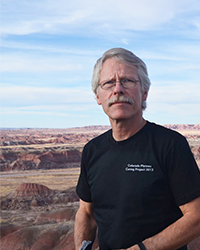
Paul Olsen is a professor of Earth and Environmental Sciences at the Lamont–Doherty Earth Observatory of Columbia University in Palisades, New York, and is a research associate at a number of museums, including New York’s American Museum of Natural History.
His interest in geology, and paleontology and dinosaurs in particular, was evident when, as a teen in New Jersey, he and a friend found dinosaur footprints. They led a successful campaign to have the site preserved, and the Riker Hill Fossil Park is now a National Natural Landmark, for which Olsen was given a Presidential Commendation by Richard Nixon.
Paul interests include climate change over geological time scales, the influence of variations of the Earth's orbit on climate and sedimentation, the end-Triassic mass extinction that set up the dominance of the dinosaurs, and excavations at major fossil vertebrate sites throughout North America, Morocco, and China.
Paul has appeared in many documentaries on the history of life, climate, and environmental change.
Having a deep interest in in the fine arts, he worked his way through college as a graphic artist and painter, while his passion for the “Dawn of the Age of Dinosaurs” expresses itself through guiding many scientific and general interest fieldtrips from North Carolina to Nova Scotia, the western US, and Morocco.
- M. Phil. and Ph.D. in biology, Yale University, 1984
- B.A. in geology, Yale University, 1978

Vertebrate Display Hall at the Beneski Museum of Natural History on the campus of Amherst College in Amherst, MA.

Thomas Cole’s “View from Mount Holyoke, Northampton, Massachusetts, after a Thunderstorm—The Oxbow”, at the Metropolitan Museum of Art (right) and a recent photograph from a similar vantage point (left).
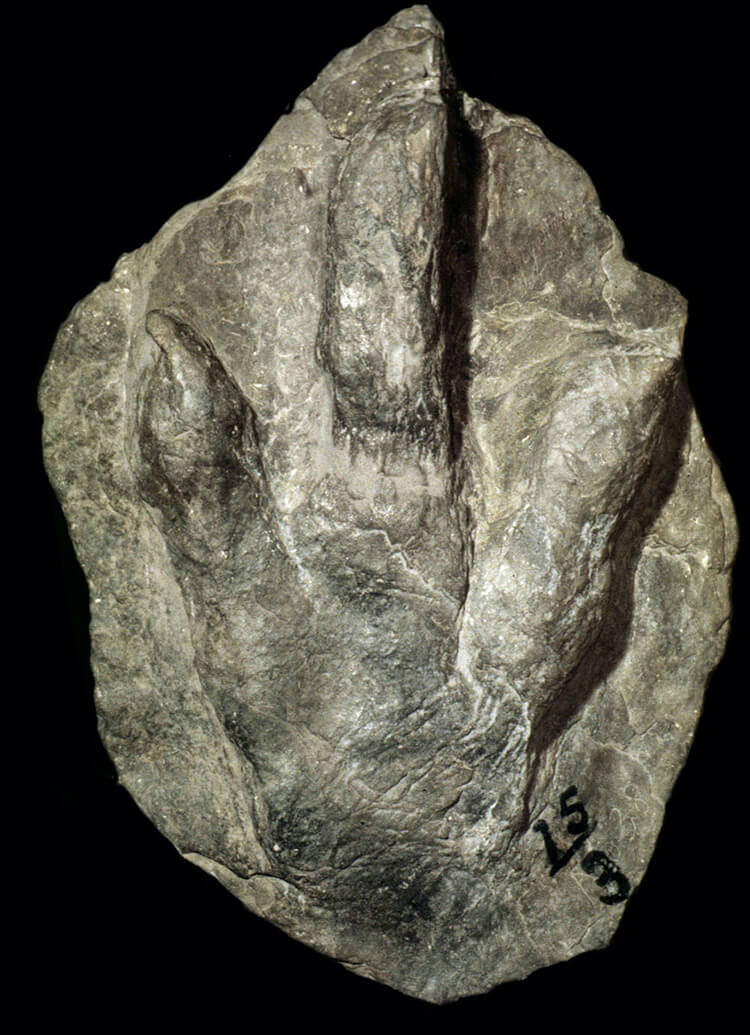
One of hundreds of Eubrontes footprints at the Dinosaur Footprints Reservation in Holyoke, MA. The classification of this therapod print is based on the shape, as opposed to the genus which is not yet known.
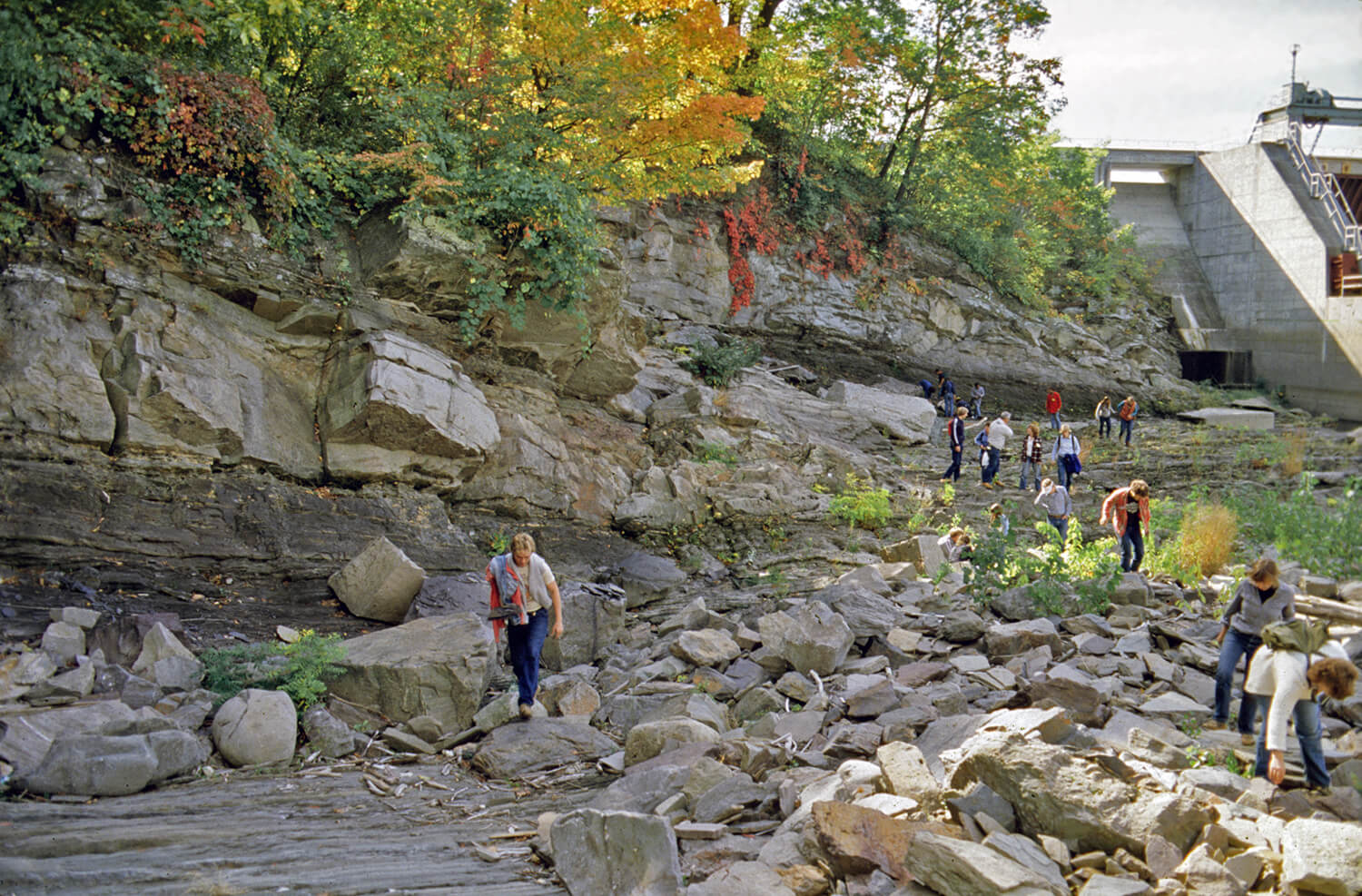
“Prospecting” for fish fossils at Turner Falls.

An example of the latest Triassic / Early Jurassic lacustrine genus Semionotus, a bony fish related to living gar species.

The Portland Brownstone Quarry in Portland, CT, a source for classic “brownstones” for buildings as well as thousands of dinosaur footprints and some bones.

Alexander Hamilton statue at Paterson Great Falls, NJ, birthplace of the American Industrial Revolution. Hamilton co-founded the “Society for Establishing Useful Manufactures” in 1791 to promote industry in the young United States.

Impressive cliffs of Late Triassic organic-rich lacustrine mudstones of the Lockatong Formation, representative of the deepest phases of the Newark basin lakes, at the Eureka Quarry.
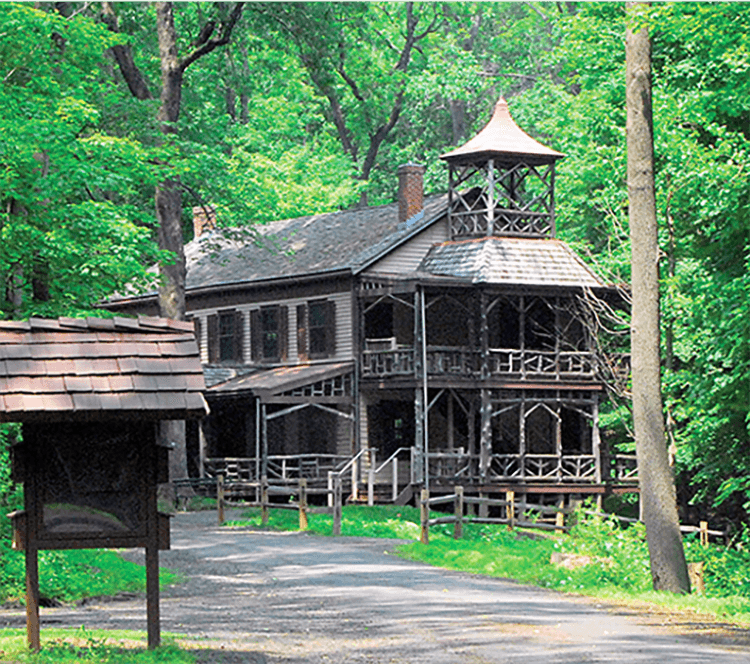
One of a dozen buildings in the “deserted village of Feltville”, all that remain of an 18th century mill town and resort overlooking the Watchung Reservoir in New Jersey.

The Olana State Historic Site on the Hudson River is a historic house museum and property that was home to Frederic Edwin Church, one of the major figures in the Hudson River School of landscape painting.

The American Museum of Natural History at Central Park West and 79th Street. The 28-building complex has been at its current site since 1869. Its remit is “To discover, interpret, and disseminate—through scientific research and education—knowledge about human cultures, the natural world, and the universe.”
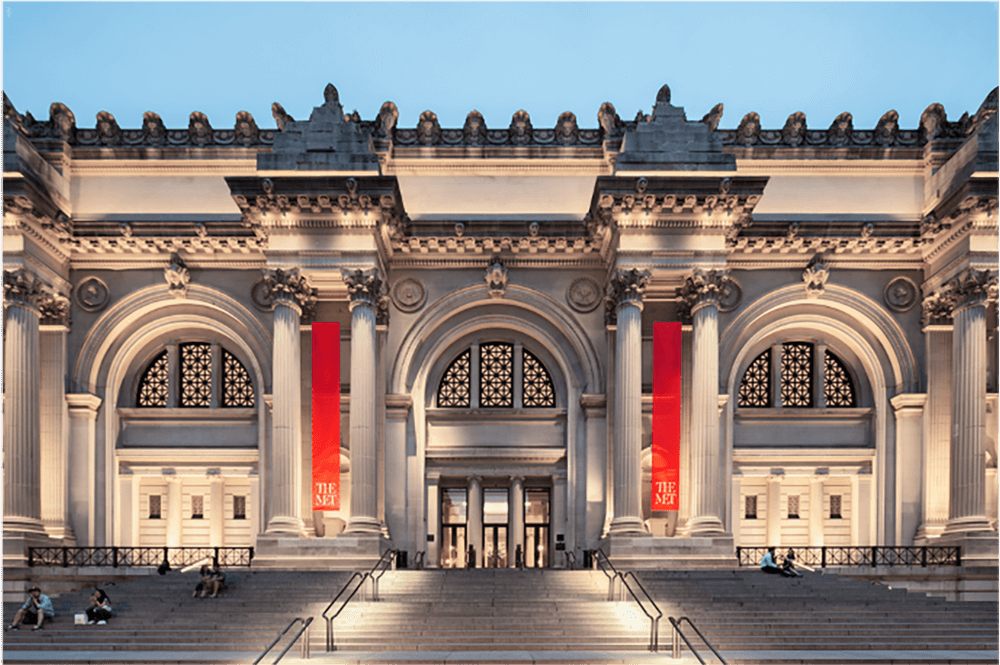
The Metropolitan Museum of Art , “the Met”, at 5th Avenue and 82nd Street is the largest art gallery in the United States. The American Wing includes a large collection of Hudson River School works by Thomas Cole, Frederic Church and Asher Durand.

The Palisades on the Hudson River. The basalt cliffs are the margin of a 200 million year old diabase sill, formed by the intrusion of molten magma upward into sandstone. The molten material cooled and solidified before reaching the surface.
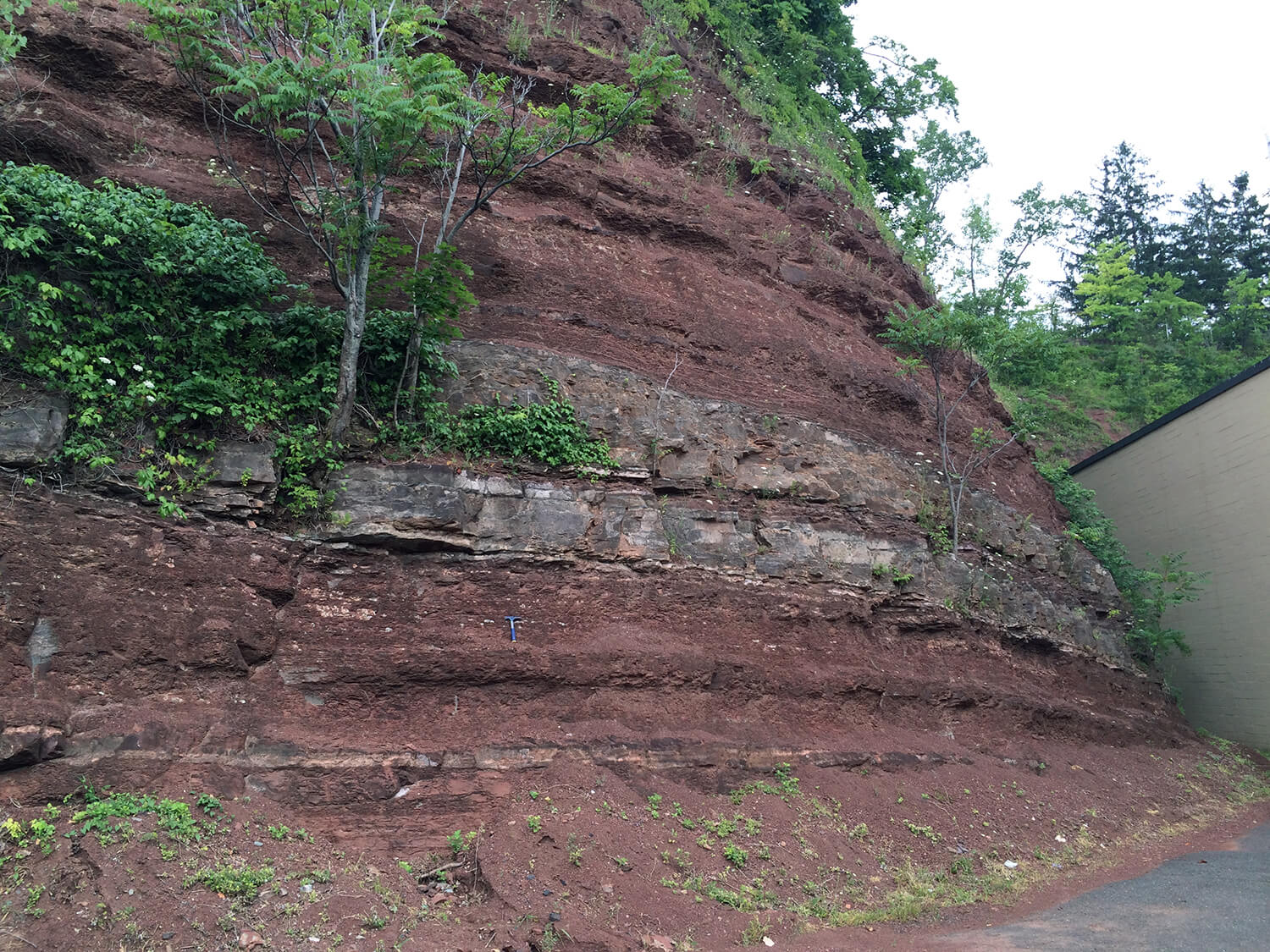
A cliff face near the abandoned Schuyler Copper Mine in Bergen County, NJ. Operations began in 1715, making it one of the oldest copper mines in the United States.

Late Triassic lacustrine redbeds at the Blooming Glen Quarry. These are crushed for aggregate and are rich in fish and reptile fossils.
